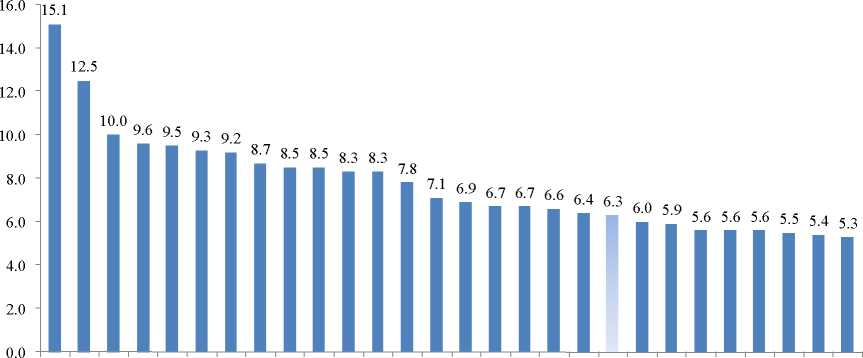32
C. Policy Two: Removal of the Provincial Sales Tax on Purchases of Machinery and
Equipment
It has long been recognized that investment in machinery and equipment (M&E)
is a key driver of productivity growth. M&E investment has historically been weak in
Canada relative to other OECD countries. According to the most recent OECD data,
Canada in 2004 devoted 6.3 per cent of GDP to M&E, ranking 20th out of 28 OECD
countries (Chart 9).This situation hurts our productivity performance. Indeed, Industry
Canada economists estimate that our lower level of M&E intensity relative to the United
States accounted for 30.3 percent of the Canada-US labour productivity gap in the
business sector in 2001 (Rao, Tang, and Wang, 2004).
Chart 9: Gross Fixed Capital Formation: Machinery and Equipment
as a Percentage of GDP in Selected OECD Countries, 2004*
Per cent


Source: OECD (2006) OECD Factbook 2006: Economic, Environmental and Social Statistics, ISBN 92-64-03561-3, P. 44.
Note: Data in 2004 are not available for countries with an asterisk, so the latest year estimates were used.
The cost of capital affects investment decisions. Indeed, Ab Iorwerth and
Danforth (2004), in a survey of the literature on the elasticity of investment with respect
to the use cost of capital, conclude that there is increasing evidence that lowering the user
cost of capital would have a significant impact on firm investment and that policy
initiatives should be focused on permanent changes in the user cost of capital.
One reason for lower M&E investment in Canada may be the higher cost of
capital in Canada, as proxied by the marginal effective tax rate (METR) on capital. The
CD Howe Institute reports that Canada has one of the highest METRs in the world
(Mintz, 2006). The METR was 36.6 per cent in Canada in 2006, sixth out of 45 countries.
More intriguing information
1. Methods for the thematic synthesis of qualitative research in systematic reviews2. The purpose of this paper is to report on the 2008 inaugural Equal Opportunities Conference held at the University of East Anglia, Norwich
3. Optimal Private and Public Harvesting under Spatial and Temporal Interdependence
4. Factores de alteração da composição da Despesa Pública: o caso norte-americano
5. 101 Proposals to reform the Stability and Growth Pact. Why so many? A Survey
6. Education as a Moral Concept
7. Natural hazard mitigation in Southern California
8. Trade Openness and Volatility
9. Density Estimation and Combination under Model Ambiguity
10. Julkinen T&K-rahoitus ja sen vaikutus yrityksiin - Analyysi metalli- ja elektroniikkateollisuudesta